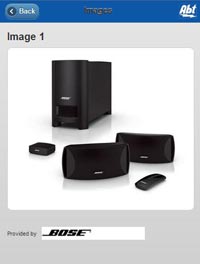Commentary
The Showrooming Battle: Coming To A Small Screen Near You
- by Steve Smith , Staff Writer @popeyesm, July 19, 2012
 So much is made of the threat of smartphone lookups in store aisles that it is easy to forget that the next real battle will take place on the device
itself. Not all shopping apps are created equal.
So much is made of the threat of smartphone lookups in store aisles that it is easy to forget that the next real battle will take place on the device
itself. Not all shopping apps are created equal.
I know that Amazon’s apps will beat out Barnes & Noble’s without breaking a sweat, so I almost always use Amazon’s when in-store at B&N. But for electronics I may well default to Best Buy’s own app when in their store. Their product information is deep and uniform. I can even do cool product comparisons in side-by-side spec listings. Showrooming paranoids have a tendency to lump all smartphone experiences together as a single unified threat.
In fact, more attention must be given to the actual experience on the handset when in-store, both by first-party apps fighting to keep consumers in the brand’s loop and third parties looking to hijack consumers. All the data points to people relying on their cell phones for increasingly sophisticated product research tasks. There is an awful lot of consumer groundwork going on during prime-time TV viewing as people pop through product catalogs.
And so the quality of mobile product information is bound to become an important point of differentiation. It is pretty much a given now that anything people did on the Web for the last 15 years they eventually will be doing on devices.
Anticipating that consumers will be looking for the depth and quality of product information on smartphones they have come to expect on the Web, the product information provider WebCollage announced this week it was converting more than 50,000 SKUs for optimal mobile use. The company supplies product content to many major retail sites on the Web. It claims Disney, GE, Lego, L’Oreal, P&G, Samsung and Sony among its 1,000 manufacturing customers who are publishing and controlling their product information.
The company says that its goal is to bring to mobile product listings the same depth of information and richness of multimedia. Use a Web or HTML5 browser on this link to see an example of the mobile-optimized listing for a Lexmark Color Laser printer sold at Staples. Use this one for a look at Bose speakers at the ABT site. Translation brings video versions of a 360-degree product spin to mobile and allows for even deeper research with downloadable PDFs.
Manufacturers with a publishing system that allows them to syndicate content to retailers in this way also put some control in the product brand’s hands. They have more power to edit specs, and in some cases pricing on the fly and perhaps respond to real-time trends that are occurring as people bring the Internet into stores.
It is all very good, and demonstrates how effective richer content be in making the sale. A year and a half ago we applauded retail sites that actually had a full-screen image or two on their mobile site. In short order the bar has gotten higher.




I agree: Retailers must adopt omnichannel strategies to compete with customers' mobile/in-store access to shopping info. One way of doing this is to display elements of online research (self-serve browsing, engaging visual media and streaming content) on a touchscreen installed in-store, so customers won't rely on outside mobile apps. That's the approach we've taken at iQmetrix, and it has driven great results for our retail clients. Have a look: http://www.iQmetrix.com/products/xq